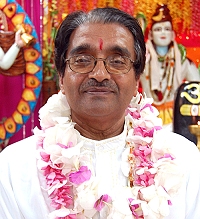From an interview with Paramacharya of SWAHA, H.H. Pt. Hardeo Persad
The Shiv lingam symbolises a state of infinite power. Lord Shiva is the substratum of all existence; He is Param Shiva. In his meditative form as Shivaji, He symbolises the virtue of dispassion, and every symbol on his body carries deep spiritual meaning.
He is depicted as white in colour, with a blue throat. The blue throat represents the destruction of materialism, the main poison of the world. White is the basis of all colours; if it is passed through a prism, it emerges as all the colours of the spectrum. Thus, the colour white represents all pervasiveness. Thus, everything emerges from and returns to Shiva.
Shiva holds a damaru, a drum. From that drum there emerged the Maheshwar sutra, the arrangement of the Sanskrit alphabet. The damaru also creates rhythm, and everything in this world is rhythmic and cyclical. From it emanates the first sound vibration. Shivaji, Lord of the dance, is master of the dance of creation as well as dissolution of the ego and the world.
His matted locks are also deeply significant. In the human body there are five major vital airs: praana, apaana, samaana, udaana and vyaana vaayu and five minor ones: naga, kurma, krkara, devata and dhananjaya vayu. Together they control all the body’s metabolic activity. Shiva sits in meditation for thousands of years without any activity and tying the matted locks signifies harnessing all the vital airs. They are placed in a state of inertia so that He has absolute control over the human body as the Maha Yogi.
The river Ganga that flows from his hair is the stream of devotion in all of us. Shiva represents pure dispassion. Thus, with dominance over all the activities of the body and dispassion, one can develop the highest state of pure devotion (bhakti). The trishul or trident represents the triguna: Brahma, Vishnu and Shiva (Creator, Sustainer, Dissolver). It also signifies the three states of time: past, present and future, as well as the three planes of existence: bhu, bhuvah, swah (physical, astral, causal). Shiva knows past, present and future and is beyond time. He bestows blessings on the three planes of existence. The serpent coiled around His neck represents the individual ego, which should adorn the Cosmic Ego, Shivaji. It also represents the cycle of time in years. He is the Master of time, Maha Kaal.
The auspicious celebration of Maha Shiv Raatri reminds each individual of the journey one must embark upon in order to realise Shivaji and to purify the intent with which it is done. The ritualistic actions of jal-offering, havan, abhishek, fasting, mantra-jap and pujaa, combined with the practice of rising above the limitations of this world, takes one nearer to the ultimate goal of Divinity.



